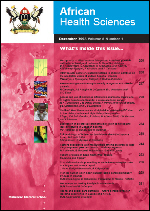
|
African Health Sciences
Makerere University Medical School
ISSN: 1680-6905
EISSN: 1680-6905
Vol. 16, No. 1, 2016, pp. 276-281
|
 Bioline Code: hs16037
Bioline Code: hs16037
Full paper language: English
Document type: Research Article
Document available free of charge
|
|
|
African Health Sciences, Vol. 16, No. 1, 2016, pp. 276-281
| en |
Stapedotomy and its effect on hearing – our experience with 54 cases.
Adedeji, Taiwo Olugbemiga; Indorewala, Shabbir; Indorewala, Abuzar & Nemade, Gaurav
Abstract
Introduction: This study reviews the cases of stapedotomy and evaluates its effectiveness at improving hearing loss in patients with otosclerosis.
Materials and methods: Retrospective review of patients’ records who had clinical and audiometric diagnosis of otosclerosis from January to December 2012.
Results: A total of 54 stapedotomy surgeries (52 unilateral and 1 bilateral surgeries) were received. Average post-operative ABG for 0.5, 1, 2 and 4 KHz showed that 61.1% had complete closure of ABG (ABG < 10 dB) compared with 1.6% preoperatively and 85.2% had closure of ABG to within 20dB compared with 4.7% preoperatively (t – 13.89, p = 0.000). More than 94% had hearing improvement and 81.5% had ABG closure greater than 10 dB postoperatively (mean gain 23.38 ± 12.37, t = 13.89, p = 0.000). A total of 13% complications were recorded with TM perforation (5.6%) being the commonest complication.
Conclusion: Stapedotomy is an effective surgical procedure for the treatment of otosclerosis which leads to improvement in patients’ quality of life. A favorable hearing outcome can be obtained by the combination of experienced hands with minimal surgical trauma and appropriate surgical technique.
Keywords
Otosclerosis; air-bone gap; conductive hearing loss; Stapedotomy
|
| |
© Copyright 2016 - African Health Sciences
|
|
